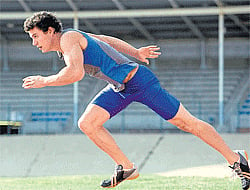Ever wondered why sprinters continue to beat their own records more frequently? It is because technological interventions helping them improve their performance more consistently than before, researchers say.
Steve Haake of Sheffield Hallam University’s Centre for Sports Engineering in the UK has developed a model called the “performance-improvement index” that uses very simple physics to compare the relative growth of top athletes in different sports over the last 100 years.
The model shows that the performance-improvement index in the men’s 100m sprint is increasing at a time when those of other events, such as javelin and swimming, have plateaued or decreased. Some of the reasons for these changes, Haake explained, are because of technological interventions that have changed the face of the sport.
“One way of finding out how exactly technology affects sporting performance is to examine the physics involved. We can then try to quantify the effect of technology on sporting events — and find out whether it really is all about the equipment,” Haake said in an article published in the journal Physics World.
Haake also explained the step-change in the men’s 100m in the mid-1970s with the introduction of fully automated timing. In swimming, an unprecedented 25 and 47 world records were broken in 2008 and 2009, respectively, with tight-fitting, full-body swimsuits seen as the main reason, he said.
The performance of javelin throwers, for example, was improving drastically up until the mid-1980s, to a point where officials were concerned for crowd safety. At that time, javelins would float to the ground and land flat, meaning it was very hard to tell where the tip had hit the ground.
The International Association of Athletics Federations (IAAF) changed the specifications of the javelin, moving its centre of mass towards the tip by four cm and so forcing the javelin to land on its tip, thus reducing throwing distances by about nine metres.
The swimsuits, which have now been banned by swimming’s ruling body (FINA), were relatively tight and reduced the cross-sectional area of the body by pulling it into a more cylindrical shape, thus reducing drag.
They were made from polyurethane, which also affected the way the water flowed over the body, Haake said.
